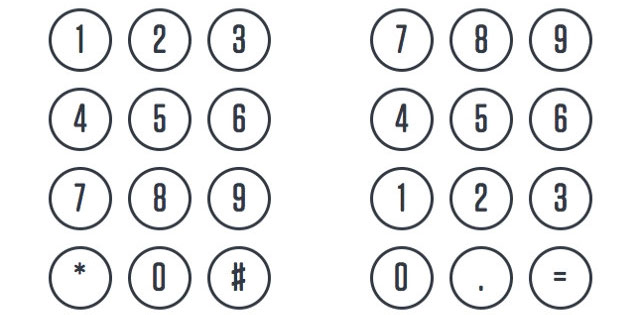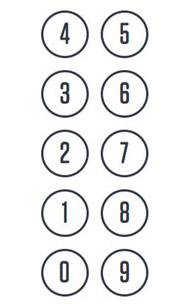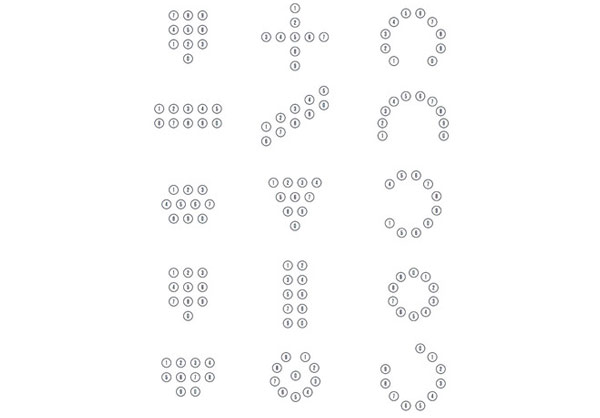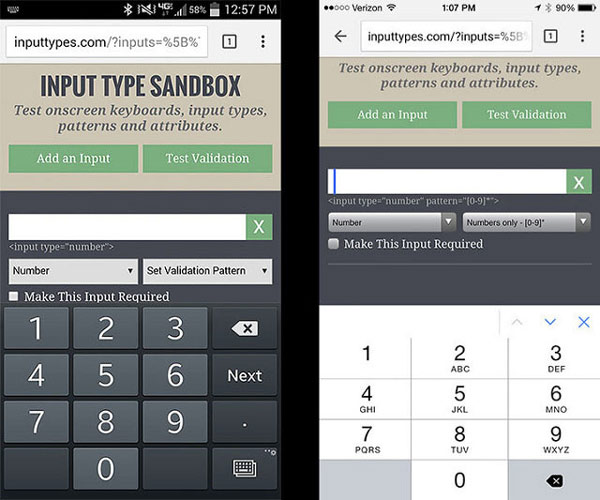Why are phone and computer number keys different?
The truth is that the number keys on the computer application on smartphones are completely different from the number keys when making phone calls. Specifically, on the computer application the numbers 7, 8, 9 are arranged at the top, while with the calling application, the numbers 1, 2 and 3 above. Why is there this difference?
The main answer lies in the development history of computers and phones since the 19th century.

Keyboard when calling (left) and keyboard in computer (right).Photo: The Next Web.
The history of computer keyboard development lasts 30 years
Since the 17th century, there have been mechanical computers, this is the precursor to computers with buttons. It wasn't until the 19th century that the computer had a digital button. In 1884, Dorr Felt invented a computer with a keyboard designed with 9 numbers equivalent to 9 digits (1-9), each number equivalent to one digit of the term, along with 8 numeric columns. equivalent to unit rows.
Example 9, the 4th column on Dorr Felt's keyboard is equivalent to 9 in 9000.
Dorr Felt's keyboard does not have a zero, to represent zero users simply without pressing any buttons.

Dorr Felt's keyboard on a computer.
By 1902, a new computer keyboard appeared, designed by James Dalton. This is the first keyboard with the appearance of zero and only 2 row keys with a total of 10 digits. Compared to Dorr Felt's computer keyboard, James Dalton's type is easier to use, even it is advertised as capable of calculating and re-checking the value of an invoice in 35 seconds.

Computer model with keyboard invented by David Sundstrand.
The popular computer keyboard design that appeared in 1914 was introduced by a Swedish inventor, David Sundstrand. With 3 rows, 3 columns and 0 at the bottom, help shorten the travel distance. This keyboard is considered to be the most optimal, allowing users to do calculations with only one hand. So far, this keyboard design is still used on most computers.
Phone keyboards are the result from many scientific studies
The number buttons for phone calls on smartphones are now sourced from the phones themselves. At the beginning of the 19th century, the phone was invented but then all calls had to be made through switchboards and on and off switches to switch calls to be made by operators. hand.
By the 1950s, long-distance phones became popular. Meanwhile, local phone numbers include 7 numbers, area codes include 4 numbers. To make a long distance call, the operator has to dial a total of 11 numbers, which can easily lead to a wrong number dial. And to reduce the wrong click rate, AT&T telecom engineers have devised a new number plate.
Many digital sorting schemes are offered, ranging from the arrangement of circles, triangles and cross-alignments. At the same time, the responsibility of dialing numbers is transferred to the callers thanks to the introduction of automatic switchboards.

Number plate of the operator in the 1950s. Photo: The Next Web.
In 1960, RL Deininger published a study that suggested that users liked a keyboard opposite of a computer keyboard, that is, the number increased from left to right, top to bottom.

15 proposed new numeric key arrangement options.Photo: The Next Web.
Finally, AT&T has chosen to design 3 rows, 3 columns and 0 at the bottom. And it has become a popular way of arranging keys in phones until today, unaffected even if the phone keypad has the ability to type characters.
Impact on modern equipment
The design of the computer keyboard is inherited on the next computer keyboard with the 7, 8, 9 numeric keys at the top and the proximity calculation buttons. This design makes it easy for users to perform calculations only with the right hand.

Most applications of both iOS and Android operating systems have the same number of keys as phones.Photo: The Next Web.
It is possible that the arrangement of the keyboard on modern smartphones inherited from phones with buttons with the design of the top 1, 2, and 3 ranges became familiar from tens of years ago.
In short, the computer and phone number keys arranged today are due to the development of devices in history.
See more:
- Forget the keyboard and mouse, just a trumpet this guy can kill the monsters in the game "Doom"
- See hackers and developers install DOOM on everything, even in the DOOM game itself
- Bitcoin wallet 'inviolable' used by John McAfee was hacked by a 15-year-old boy to play DOOM
- If you successfully break this island, this super-difficult game will give you 5000 USD
You should read it
- Do you really need a numeric keypad on your keyboard?
- The easiest way to view my phone number
- How to Change the phone number associated with Apple ID on iPhone
- How to enable the numeric keypad as a mouse on Windows 11
- How to change phone numbers on Facebook
- Instructions for deleting Facebook phone numbers
- How to create a virtual phone number to receive messages
- The 'first' of the phone
May be interested
- How to Fix Laptop Keys
 today's tipsmake will show you how to fix unresponsive laptop keys. if after cleaning the base frame and reinstalling the keys the problem is still not resolved, you may need to completely replace the specific key or the entire keyboard.
today's tipsmake will show you how to fix unresponsive laptop keys. if after cleaning the base frame and reinstalling the keys the problem is still not resolved, you may need to completely replace the specific key or the entire keyboard. - Instructions for deleting Facebook phone numbers
 delete facebook phone numbers to enhance facebook security, ensure user privacy.
delete facebook phone numbers to enhance facebook security, ensure user privacy. - How to create a virtual phone number to receive messages
 you have tried many ways to create virtual phone number to set up multiple gmail accounts but it is effective. click here to get a simple and detailed way to create a virtual phone number!
you have tried many ways to create virtual phone number to set up multiple gmail accounts but it is effective. click here to get a simple and detailed way to create a virtual phone number! - How to Restore iPhone Settings Using Hardware Keys
 this article shows you how to force a frozen iphone to restart. restoring iphone settings using hardware keys requires you to press a number of key combinations depending on the model. if forcing your iphone to restart doesn't work, you can also refer to how to fix operating system errors by connecting your iphone to your computer.
this article shows you how to force a frozen iphone to restart. restoring iphone settings using hardware keys requires you to press a number of key combinations depending on the model. if forcing your iphone to restart doesn't work, you can also refer to how to fix operating system errors by connecting your iphone to your computer. - Select the first beautiful online phone number in Vietnam for VND 50,000
 users can select the favorite number along with vietnamobile's phone number.
users can select the favorite number along with vietnamobile's phone number. - How to Get a Temporary Phone Number in the US
 a temporary phone number is a good way to protect privacy in situations such as a 'blind date' (a date between two strangers) or a meeting set up on an online classified site. you can use temporary phone numbers through applications that connect using mobile minutes or simple wifi networks. prepaid cell phones and sim cards are also simple options for getting a temporary phone number. skype and google voice are popular options for getting an additional phone number for short-term use (or you can keep it long-term if you want).
a temporary phone number is a good way to protect privacy in situations such as a 'blind date' (a date between two strangers) or a meeting set up on an online classified site. you can use temporary phone numbers through applications that connect using mobile minutes or simple wifi networks. prepaid cell phones and sim cards are also simple options for getting a temporary phone number. skype and google voice are popular options for getting an additional phone number for short-term use (or you can keep it long-term if you want). - How to add trusted phone numbers to Apple ID
 you should note that a reliable phone number is all you need to gain access to your account in the event of a password loss, so make sure you only add a friend / friend's number. very confident.
you should note that a reliable phone number is all you need to gain access to your account in the event of a password loss, so make sure you only add a friend / friend's number. very confident. - How to Change Your Phone Number on iMessage
 this wikihow teaches you how to prompt your iphone's number to appear in imessage if you have a new number, as well as how to select an email address as the point from which to send your messages instead of using your phone number....
this wikihow teaches you how to prompt your iphone's number to appear in imessage if you have a new number, as well as how to select an email address as the point from which to send your messages instead of using your phone number.... - How to fix some keys on the keyboard not working
 from checking your keyboard settings and running the troubleshooter to updating your drivers, there are a number of things you can try to fix broken keys.
from checking your keyboard settings and running the troubleshooter to updating your drivers, there are a number of things you can try to fix broken keys. - Summary of the features of Fn keys on laptops
 the fn key on the laptop keyboard with the full name is function. we still often call the function key. keys are often used in combination with keys f1 => f12. some new laptop lines often incorporate some other keys.
the fn key on the laptop keyboard with the full name is function. we still often call the function key. keys are often used in combination with keys f1 => f12. some new laptop lines often incorporate some other keys.










 Microsoft will remove virtual assistant Cortana while installing Windows 10
Microsoft will remove virtual assistant Cortana while installing Windows 10 Huawei employees 'dumbfounded' posted tweets to celebrate the new year from heavily punished iPhones
Huawei employees 'dumbfounded' posted tweets to celebrate the new year from heavily punished iPhones Microsoft wants to 'death' technology using passwords on Windows 10
Microsoft wants to 'death' technology using passwords on Windows 10 Take the Google Maps suggestion to save 15 minutes, this guy has a trip to remember life
Take the Google Maps suggestion to save 15 minutes, this guy has a trip to remember life It's dangerous to use laptops for a long time, not everyone knows
It's dangerous to use laptops for a long time, not everyone knows Will dual-boot options be added soon with Windows 10?
Will dual-boot options be added soon with Windows 10?